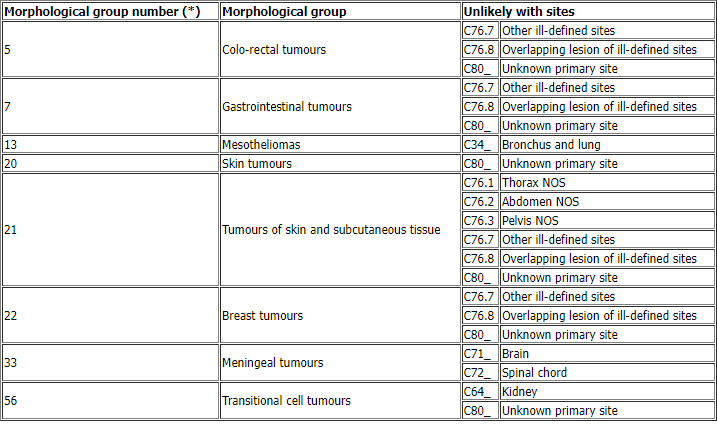EUROCARE-4 data quality check procedures
Check of individual data fields
The values in each data field must have a valid format, as defined in the EUROCARE-4 study protocol. Cancer topography and morphology codes are checked versus ICDO-3 codes listed in the WHO year 2000 publication.
Consistency checks between different data fields
- consistency between dates of birth, diagnosis and follow-up
- site-morphology combination are first checked according to the standard criteria published in IARC Techincal Report No. 42. Then a list of further EUROCARE criteria, described in the following Table, is considered
- age-site, age-morphology, sex-site, and sex-morphology unlikely combinations are the same listed in the abovementioned: IARC Technical Report No. 42, with few additional items that are reported in the Table below
Table 2. Eurocare-4 added site-morphology checks

Standardization of Topography and Morphology codes in the EUROCARE-4 DataBase
Topography and Morphology coding system
According to the EUROCARE-4 protocol, cancer site could be provided according to ICD-9, ICD-10 or ICDO, while morphology should be given in ICDO-2 or ICDO-3. ICDO classification was mostly used by participating registries to code topography, followed by ICD-10, while ICD-9 was rarely used. Morphology was in most cases coded either according to 2nd or 3rd revision of ICDO, depending on the period of diagnosis.
The ICDO-3 classification system has been chosen as the common coding system for site and morphology in the EUROCARE-4 database. ICDO-3 was also the basis for the subsequent data checking and management procedures. This choice allowed to minimize the need of data trans-coding and to maximize the consistency with IARC checks.
Conversion procedures for Morphology
Morphology has been translated first. Conversion from ICDO-2 to ICDO-3 morphological codes was performed automatically by means of a trans-coding table reported here for reference ( ICDO2 to ICDO3). An analogous table has been used for the automatic conversion of the sporadic cases coded according to ICDO-1, that were still present (ICDO1 to ICDO2).
Conversion procedures for Topography
Site codes in ICD-9 or ICD-10 have been converted into ICDO-3 topography codes by means of trans-coding tables provided here for reference (ICD9 to ICDO and ICD10 to ICDO).
ICD-9/10 classifications also provide information on the tumour behaviour and, in some cases, on the tumour morphology. ICD-9/10 codes indicating benign, in-situ, or borderline malignancy tumours have been translated only after checking that the behaviour code of the tumour was compatible. Similar controls have been applied to ICD-9/10 codes involving morphology information. The compatibility conditions between ICD-9/10 topography and ICDO-3 morphology and behaviour are shown in the Table: Conditions for TransCoding Topography . If these conditions were not met topography codes have not been translated and were managed subsequently, by means of the data check procedures, as topography-behaviour or topography-morphology inconsistencies. When morphology was blank, the morphological information carried by ICD-9/10 topography codes was not lost, and a generic morphological code has been imputed.


